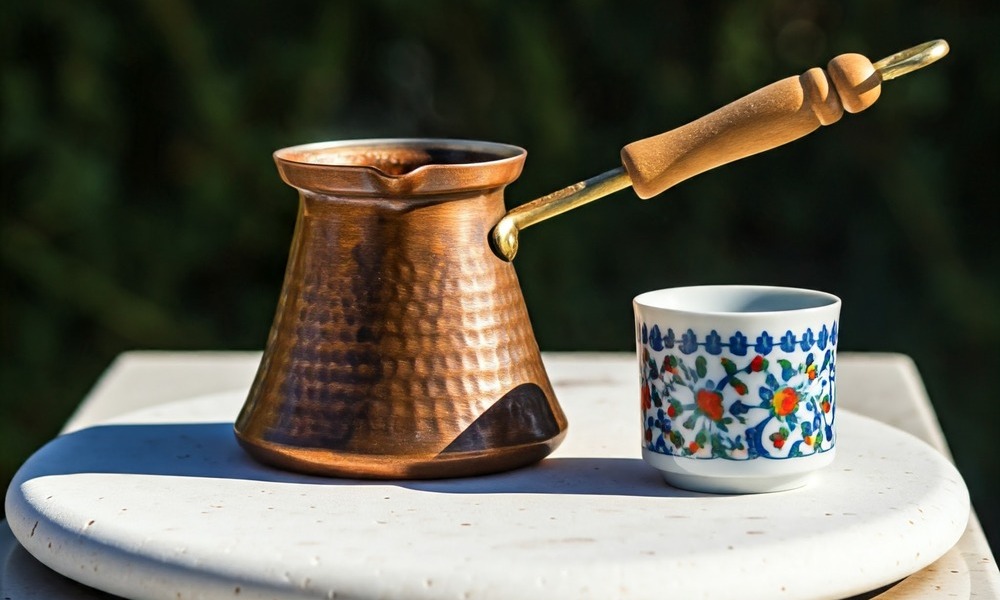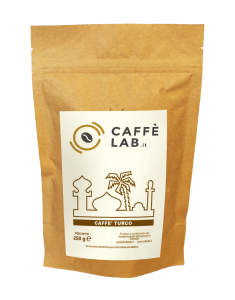

Turkish coffee is one of the oldest and most fascinating coffee preparations in the world, a ritual that has been passed down through centuries and still holds significant cultural and social value today. Prepared using the distinctive coffee pot known as a Cezve or Ibrik, this brewing method has captivated numerous countries, each developing its own variations and local traditions. The significance of Turkish coffee extends beyond the drink itself—it represents a moment of pause, conviviality, and sharing. In this article, we will explore the history of this ancient preparation, the origins of the words Cezve and Ibrik, traditional and modern brewing techniques, and the secrets to achieving the perfect cup.
The history of Turkish coffee
The origins of Turkish coffee date back to the 16th century when coffee consumption began spreading throughout the Ottoman Empire. It was during this period that coffee became associated with culture and social life, served in renowned public coffeehouses known as kaveh kanes. These establishments, similar to modern cafés, were gathering places where people of all social classes could meet to discuss, play games, and socialise. The Turkish coffee preparation method became renowned for its ability to enhance the drink’s flavours through the slow infusion of finely ground coffee.
Over time, coffee became a symbol of Ottoman tradition, spreading to neighbouring countries and regions influenced by the empire. This method has remained largely unchanged for centuries, and even today, its preparation is deeply linked to hospitality and welcoming customs.
Where is Turkish coffee consumed?
Today, Turkish coffee is widely enjoyed in several countries, including Turkey, Greece, the Middle East, the Balkans, and parts of North Africa. Each country has developed its own unique twist on the preparation. For example, in Greece, it is known as Greek coffee, while in Arab countries, it is referred to as qahwa. Despite the different names and variations, the core concept remains the same: an unfiltered coffee, slowly brewed with meticulous attention to preserving its aromas and producing the characteristic froth on top.
Turkish coffee is often served on special occasions and social gatherings. In many cultures, it is an essential part of daily life, frequently accompanied by traditional sweets such as lokum (Turkish delight) or baklava. Offering a cup of Turkish coffee is considered a gesture of courtesy and hospitality—a practice that has endured for centuries.
The traditional preparation of Turkish coffee
Brewing Turkish coffee requires meticulous attention to every step. Here is the traditional process:
- Grinding the Coffee: The coffee must be ground extremely fine, almost to a flour-like consistency. This is crucial for allowing the coffee to blend seamlessly with water during brewing, ensuring a smooth texture.
- Using the Cezve/Ibrik: The coffee pot, known as Cezve (or Ibrik), is traditionally made of copper or brass and features a long handle to facilitate handling over the flame. The Cezve is filled with cold water, then finely ground coffee and sugar (if desired) are added. The sugar must be stirred before heating to ensure even distribution.
- Slow Brewing: The Cezve is placed over a low flame, allowing the coffee to heat gradually. This slow process helps develop a thick, dense foam on the surface, which is the hallmark of well-prepared Turkish coffee. Once the foam reaches the brim of the Cezve, it is gently stirred and poured into cups.
- Serving: The coffee is poured directly into cups without filtering, allowing the grounds to settle at the bottom during consumption. This characteristic gives Turkish coffee its rich and intense flavour.
Specialty Turkish coffee preparation
In recent years, Turkish coffee has also made its way into the specialty coffee world, becoming an art form in competitions held by the Specialty Coffee Association (SCA). In these modern adaptations, the quality of the coffee beans is paramount. Carefully selected beans with distinct aromatic profiles—often featuring notes of dried fruit, spices, and chocolate—are used, typically roasted at medium or light levels to highlight their unique flavours.
In specialty brewing, special attention is given to grind size, coffee-to-water ratio, and extraction temperature. Baristas competing in championships aim to achieve dense foam, a rich body, and a complex aromatic profile. This innovation has elevated the appreciation of this traditional technique, pushing it towards new frontiers of flavour.
The best coffee blends and grind size
Traditionally, Turkish coffee is made using coffee blends that include a percentage of Robusta beans to ensure full-bodied texture and a thick crema, combined with Arabica beans for enhanced aroma. The selected blends are often roasted to a medium or dark level to emphasise notes of chocolate, dried fruit, and spices like cinnamon or cardamom. However, in specialty variations, single-origin coffees with well-balanced aromatic profiles and structured body are preferred.
A fine grind is a fundamental requirement for this preparation. If the coffee is ground too coarsely, the desired texture won’t be achieved, compromising the drinking experience. A powder-like grind allows the coffee to fully release its aromas during the slow infusion process in the Cezve.
Historical anecdotes about Turkish coffee
Turkish coffee has always played a central role in Ottoman culture. One fascinating historical anecdote involves Sultan Murad IV, who ruled in the 17th century. Fearing that coffee consumption could encourage subversive gatherings and undermine his authority, Murad IV banned coffee, along with tobacco and alcohol. Violators faced severe punishments, including execution. However, despite the prohibition, coffee continued to be secretly consumed in homes and hidden establishments, demonstrating the strength of tradition and the deep social importance of coffee.
Recommended blend: Mokaflor’s Turkish coffee blend
To brew authentic Turkish coffee, selecting a high-quality blend is essential. The Mokaflor Turkish coffee blend is specially designed to offer a perfect balance of body and aroma, with medium roasting and an ultra-fine grind—ideal for Cezve or Ibrik preparation. This blend features hints of dried fruit, spices, and a subtle touch of cocoa, making it the perfect choice for an exceptional Turkish coffee experience. You can find this blend [here].
 Turkish coffee is far more than just a drink—it is a centuries-old tradition that connects different peoples and cultures. Whether you choose to follow the classic preparation method or experiment with specialty coffee techniques, using a Cezve/Ibrik allows you to explore a world of ancient and captivating flavours. With the right grind size and a premium blend like Mokaflor’s, you can bring centuries of coffee history and culture into your cup. Preparing Turkish coffee isn’t just a daily habit, but a way to connect with a cherished tradition that continues to be loved worldwide.
Turkish coffee is far more than just a drink—it is a centuries-old tradition that connects different peoples and cultures. Whether you choose to follow the classic preparation method or experiment with specialty coffee techniques, using a Cezve/Ibrik allows you to explore a world of ancient and captivating flavours. With the right grind size and a premium blend like Mokaflor’s, you can bring centuries of coffee history and culture into your cup. Preparing Turkish coffee isn’t just a daily habit, but a way to connect with a cherished tradition that continues to be loved worldwide.